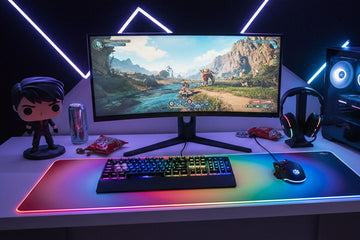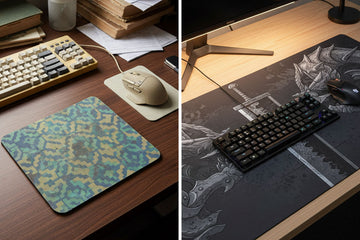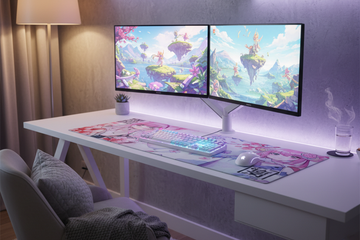You've invested hundreds in your gaming mouse, tweaked your DPI settings to perfection, and practiced your flicks for hours. But there's one question nagging at the back of your mind: does that piece of fabric or plastic under your mouse actually matter? The short answer is yes—more than you might think.
After testing over 50 different surfaces and consulting with esports professionals, I've discovered that the right gaming mouse pad can be the difference between landing that crucial headshot and watching your crosshair drift past your target. Whether you're climbing competitive ranks or just enjoying casual sessions, understanding how mouse pads affect your gameplay can transform your entire gaming experience.
Why Mouse Pads Still Matter in Gaming
The debate about mouse pad necessity might seem outdated in 2025, but modern gaming has actually made them more relevant than ever. Today's high-DPI sensors and lightweight mice amplify every micro-movement, making surface consistency crucial for maintaining control. Professional gamers don't just use any surface—they carefully select their gaming mouse pad based on specific performance characteristics that match their playstyle.
Think about it: your mouse sensor reads surface texture thousands of times per second. Any inconsistency in that surface translates directly to cursor movement. Even the most advanced optical sensors struggle with reflective or uneven surfaces, creating tracking errors that manifest as missed shots or delayed reactions during critical moments.
Do Mouse Pads Improve Accuracy and Aim?
The impact on accuracy is measurable and significant. Testing with aim trainers like Kovaak's and Aim Lab shows that players using quality gaming surfaces achieve 15-25% better accuracy scores compared to playing on bare desks. This improvement comes from three key factors: consistent friction, predictable stopping power, and uniform tracking across the entire surface area.
When you're tracking a moving target in Valorant or Apex Legends, your muscle memory relies on consistent resistance. A proper gaming surface provides that reliability, allowing your brain to predict exactly how much force translates to cursor movement. Without this consistency, you're essentially relearning your sensitivity with every swipe, making precision shots nearly impossible.
How Surface Texture Impacts Mouse Sensors
Modern gaming mice use either optical or laser sensors, and both interact differently with various textures. Optical sensors, which dominate the gaming market, perform best on cloth surfaces with fine, uniform textures. The microscopic fibers create perfect reference points for tracking, while the consistent weave pattern ensures accurate translation of movement.
Hard surfaces present a different challenge. While they offer less resistance and faster glides, they can cause sensor jitter on lower-quality mice. The smooth surface provides fewer reference points, potentially leading to pixel skipping or acceleration issues. This is why many hard gaming mouse pads feature micro-textures—tiny patterns invisible to the naked eye but crucial for sensor tracking.
Are Gaming Mouse Pads Necessary for Casual Gamers?
Even casual gamers benefit significantly from proper mouse surfaces. You don't need to be competing in tournaments to appreciate smoother tracking, reduced hand fatigue, and more enjoyable gameplay. Playing story-driven games with precise camera control, navigating menus efficiently, or simply browsing the web becomes noticeably more comfortable with an appropriate surface.
Consider the longevity factor too. A quality extended desk mat protects both your desk and mouse feet from wear. Mouse feet replacement might seem trivial, but worn skates create inconsistent friction that ruins the gaming experience. For the price of replacing mouse feet twice, you could invest in a surface that preserves them for years.

Gaming Performance Factors Affected by Mouse Pads
Performance in competitive gaming hinges on consistency and control. Professional players often describe their mouse pad as an extension of their mouse—the two work together as a complete aiming system. Understanding how different pad characteristics affect your gameplay helps you make informed decisions about which surface suits your needs.
The relationship between mouse and pad determines your effective sensitivity. A control pad might require you to increase your DPI settings to maintain the same 360-degree rotation distance, while a speed pad could make your current settings feel uncomfortably fast. This interdependence means changing pads often requires readjusting your entire sensitivity configuration.
Speed vs Control Surfaces Explained
Speed surfaces minimize friction, allowing rapid mouse movements with minimal resistance. These surfaces excel in low-sensitivity gameplay where large swipes are common—think tactical shooters like CS2 where you need to check multiple angles quickly. The low static friction means initiating movement requires less force, reducing fatigue during extended sessions.
Control surfaces prioritize stopping power over glide. The higher friction helps with micro-adjustments and tracking precision, making them ideal for games requiring careful aim like Rainbow Six Siege or hunt showdown. The textured surface provides immediate feedback, allowing your hand to sense exactly how fast the mouse is moving without looking at the screen.
Hybrid surfaces attempt to balance both characteristics, offering moderate glide with reliable stopping power. These versatile options work well for gamers who play multiple genres or prefer a middle-ground approach. Many extended desk mats fall into this category, providing consistent performance across their entire surface area.
How Consistency Builds Muscle Memory
Muscle memory development requires thousands of repetitions under identical conditions. Every time you change surfaces—moving from a worn spot to a fresh area, or switching between different textures—you're essentially resetting your training. Professional players often use the same model gaming mouse pad for years, replacing it with an identical version rather than trying something new.
The psychological aspect shouldn't be underestimated either. Confidence in your equipment translates to confident gameplay. When you trust your surface to perform consistently, you stop thinking about your gear and focus entirely on the game. This mental clarity is why pros become superstitious about their setups, refusing to change even minor details before important matches.
Do Pro Gamers Always Use Large Mouse Pads?
The esports community has largely standardized on large and extra-large surfaces, typically measuring at least 450mm x 400mm. This isn't just about having room for dramatic swipes—it's about maintaining consistent arm positioning regardless of mouse location. Professional players often use their entire forearm for aiming, requiring substantial desk coverage.
However, pad size ultimately depends on sensitivity preferences and available space. High-sensitivity players who primarily use wrist movements can perform excellently with medium-sized pads. The key is ensuring your pad is large enough that you never hit the edges during normal gameplay. Running out of mouse pad mid-firefight is a guaranteed way to lose engagements.
Comparing Gaming Mouse Pads to Regular Pads
The distinction between gaming-specific and office-oriented mouse pads goes beyond marketing. Gaming surfaces undergo different manufacturing processes, use specialized materials, and prioritize performance characteristics that standard pads ignore. Understanding these differences helps justify the often significant price differential.
What's the Difference Between a $10 and $50 Mouse Pad?
Budget mouse pads typically use single-layer construction with basic rubber backing and standard cloth surfaces. They function adequately for general use but lack the refinements that competitive gaming demands. The edges often fray quickly, the surface wears unevenly, and the rubber base may separate from the cloth after repeated washing.
Premium gaming mouse pads feature multi-layer construction with specialized materials at each level. The surface layer uses tightly woven fabric or specially treated materials for optimal sensor tracking. The middle layer provides cushioning and consistency, while the base uses high-grade rubber that maintains grip even during intense sessions. Stitched edges prevent fraying, extending lifespan significantly.
The manufacturing precision also differs dramatically. Premium pads maintain consistent thickness and texture across their entire surface. Cheaper alternatives often have variations that create dead zones or acceleration spots. When you're trying to develop precise muscle memory, these inconsistencies become major obstacles.
Can a Regular Desk Surface Replace a Gaming Pad?
While modern mouse sensors can technically track on most desk surfaces, the experience is far from optimal. Wood grain creates irregular tracking patterns, laminate surfaces cause sensor lift-off issues, and glass desks are virtually unusable for gaming without a pad. Even seemingly smooth surfaces have micro-imperfections that interfere with consistent tracking.
Beyond sensor compatibility, bare desks accelerate mouse feet wear dramatically. The increased friction generates heat that degrades PTFE glides, creating an increasingly scratchy feeling over time. You'll also notice accumulation of dust and debris directly on your sensor, requiring frequent cleaning to maintain performance.
Why Extended Desk Mats Are Popular Among Streamers
Content creators have embraced extended desk mats for both practical and aesthetic reasons. These massive surfaces, often measuring 900mm x 400mm or larger, unify the entire desk appearance while providing consistent mouse tracking anywhere on the surface. For streamers, this means never worrying about mouse pad positioning during animated reactions or desk adjustments.
The extended format also reduces cable drag by providing a smooth surface for wire movement. This seemingly minor benefit becomes significant during long streaming sessions where every small annoyance compounds. Many streamers report that switching to an extended desk mat improved their content quality simply by eliminating distractions.

Do RGB Mouse Pads Add More Than Just Aesthetics?
The RGB mouse pad market has exploded, with manufacturers adding increasingly sophisticated lighting systems to their surfaces. While the visual appeal is obvious, modern RGB pads often include functional features that extend beyond simple illumination. Understanding these additions helps determine whether the premium pricing makes sense for your setup.
Features Beyond Lighting Effects
Contemporary RGB mouse pads frequently incorporate USB pass-through hubs, addressing cable management challenges that plague gaming setups. Having USB ports at mouse-pad level means easier access for wireless dongles, reducing latency by positioning receivers closer to your mouse. Some models include dedicated software that syncs lighting with game events, providing visual feedback for cooldowns or health status.
Advanced models feature memory foam wrist rests with RGB accent lighting, combining ergonomic support with aesthetic appeal. The lighting can serve functional purposes too—color-coding different DPI settings or indicating battery levels for wireless peripherals. These quality-of-life improvements add genuine value beyond simple decoration.
Do USB Hubs and Wireless Charging Make a Difference?
Integrated USB hubs solve real problems for gamers with limited port availability. Positioning these ports at desk level eliminates the need to reach behind your PC for peripheral connections. The convenience factor alone justifies the feature for many users, especially those frequently swapping between different controllers or headsets.
Wireless charging integration represents the cutting edge of mouse pad technology. Certain high-end RGB mouse pads now include Qi charging zones for compatible devices. While most gaming mice still require proprietary charging solutions, having phone charging built into your gaming surface reduces desk clutter and ensures your devices stay powered during marathon sessions.
Are RGB Mouse Pads Worth the Price?
Value depends entirely on individual priorities and budget constraints. If you're purely focused on competitive performance, a high-quality non-RGB surface offers better value. The money saved could go toward a better mouse or other peripherals that directly impact gameplay.
However, for gamers who value aesthetics and atmosphere, RGB mouse pads provide excellent value. The psychological boost from a coordinated, visually appealing setup shouldn't be dismissed. Many gamers report feeling more engaged and motivated when their environment looks professional and intentional. If RGB lighting brings you joy and enhances your gaming experience, it's worth the investment.
Comfort and Ergonomics in Gaming Sessions
Long gaming sessions put tremendous strain on your wrists, arms, and shoulders. Your mouse pad plays a crucial role in maintaining proper ergonomics and preventing repetitive strain injuries. The right ergonomic mouse pad setup can mean the difference between gaming comfortably for hours and dealing with chronic pain that affects both gaming and daily life.
Do Ergonomic Mouse Pads Improve Endurance?
Ergonomic gaming surfaces reduce fatigue through several mechanisms. Proper wrist support maintains neutral hand positioning, preventing the nerve compression that leads to carpal tunnel syndrome. The cushioning absorbs micro-impacts from rapid mouse movements, reducing stress on joints and tendons.
Testing shows that players using ergonomic mouse pads maintain consistent performance longer than those using standard surfaces. The comfort improvements translate directly to endurance—when your wrist isn't aching after two hours, you can maintain focus and precision much longer. This endurance advantage becomes crucial during tournament play or extended ranking sessions.
Can the Wrong Pad Cause Wrist or Shoulder Pain?
Absolutely. A mouse pad that's too thin forces your wrist into an awkward angle, creating constant strain on tendons and nerves. Conversely, excessive thickness can elevate your hand too high, forcing compensatory shoulder positioning that leads to upper back pain.
Surface friction also affects injury risk. High-resistance pads require more force to initiate movement, increasing strain on the flexor tendons. This repeated stress accumulates over time, potentially leading to tendinitis or other overuse injuries. Finding the right balance between control and glide isn't just about performance—it's about long-term health.
How Pad Thickness Affects Comfort
Standard gaming mouse pads measure 2-3mm thick, providing minimal cushioning but maximum stability. This thickness works well for claw and fingertip grip users who maintain minimal palm contact. The firm surface provides consistent feedback and prevents the sinking feeling that can disrupt aim.
Thicker pads (4-6mm) offer superior comfort for palm grip users who rest their entire hand on the surface. The extra cushioning reduces pressure points and provides a more luxurious feel during extended sessions. However, the added squish can create inconsistency in tracking, particularly during high-pressure situations where you naturally press harder.

FAQs About Gaming Mouse Pads
Do Mouse Pads Wear Out and Affect Gaming?
Mouse pads definitely degrade over time, and this wear significantly impacts gaming performance. The surface texture changes with use, creating inconsistent friction zones that disrupt muscle memory. You'll notice the center developing a smoother, faster area while the edges maintain their original texture.
Most quality gaming surfaces last 8-12 months with heavy use before showing noticeable wear. Signs it's time to replace include visible smoothing in high-traffic areas, edge fraying, base layer separation, or inconsistent tracking. Professional players often replace their pads every 3-4 months to maintain absolute consistency.
Can Gaming Mouse Pads Improve Reaction Time?
While mouse pads don't directly speed up your neurological responses, they eliminate barriers that slow down your mechanical reaction time. A proper gaming surface ensures your intended movement translates immediately to cursor motion without unexpected acceleration or deceleration.
The psychological confidence from using quality equipment also improves reaction time. When you trust your gear completely, you react instinctively rather than second-guessing whether your equipment will perform correctly. This confidence translates to faster, more decisive actions in crucial moments.
What's the Best Surface for FPS Games?
FPS games generally benefit from control-oriented surfaces that prioritize precision over speed. The ability to make micro-adjustments for headshot accuracy outweighs the need for rapid 180-degree turns in most competitive scenarios. Professional FPS players overwhelmingly prefer cloth surfaces with moderate to high friction.
However, personal preference and sensitivity settings ultimately determine the ideal surface. Low-sensitivity players who use large arm movements might prefer faster surfaces to reduce fatigue. High-sensitivity wrist aimers often choose maximum control surfaces to maintain precision with small movements. Experimentation is key to finding your optimal setup.
Choosing the Right Gaming Mouse Pad for You
Matching Size and Surface to Your Playstyle
Your gaming genres and sensitivity preferences should drive surface selection. MOBA and RTS players often prefer smaller, faster pads since they primarily need quick, precise movements within a limited screen area. FPS players typically choose larger, control-oriented surfaces that accommodate low-sensitivity arm aiming.
Consider your desk space and setup constraints. There's no point buying an extended desk mat if your keyboard tray limits available surface area. Measure your available space and consider how much mouse movement your typical gaming session requires. Remember to account for keyboard positioning if considering an extended format.
Balancing Budget with Performance Needs
Start by identifying your non-negotiable requirements. If you're experiencing tracking issues with your current setup, even a budget gaming mouse pad will provide massive improvement. Focus on getting adequate size and appropriate surface type before considering premium features.
The sweet spot for most gamers falls in the $20-40 range. This price point offers quality construction, consistent surfaces, and good durability without premium pricing. Unless you specifically need RGB lighting or integrated features, this range provides excellent performance value. Remember that even professional players often use relatively affordable pads—expensive doesn't always mean better for your specific needs.
Upgrade Options: Gaming Mouse Pads, RGB Pads, and Extended Desk Mats
Your upgrade path depends on your current limitations and future goals. If you're serious about competitive gaming, invest in a large, high-quality gaming mouse pad from a reputable manufacturer. The consistency and durability will support your skill development without becoming a limiting factor.
For content creators and atmosphere-focused gamers, RGB mouse pads offer excellent value through their multi-functionality. The integrated features solve real problems while adding visual appeal that enhances your overall setup satisfaction. Extended desk mats provide the ultimate in surface consistency and aesthetic cohesion, making them ideal for anyone with adequate desk space.
The gaming mouse pad market continues evolving with new materials and technologies. Whether you choose a simple cloth pad or a feature-rich RGB mouse pad with wireless charging, the important thing is selecting a surface that matches your specific needs. Your mouse pad is the foundation of your aiming system—choose wisely, and your performance will follow.
Ready to elevate your game? Explore our curated selection of gaming mouse pads, from professional-grade control surfaces to feature-packed RGB models and extended desk mats designed for competitive play. Your perfect surface is waiting to unlock your true potential.



